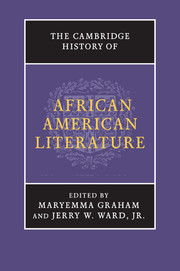Book contents
- Frontmatter
- Introduction
- PART I AFRICAN AMERICAN LITERATURE FROM ITS ORIGINS TO THE TWENTIETH CENTURY
- PART II AFRICAN AMERICAN LITERATURE IN THE TWENTIETH CENTURY
- PART III AFRICAN AMERICAN LITERATURE AS ACADEMIC AND CULTURAL CAPITAL
- 24 Children's and young adult literatures
- 25 From writer to reader: black popular fiction
- 26 Cultural capital and the presence of Africa: Lorraine Hansberry, August Wilson, and the power of black theater
- 27 African American literature: foundational scholarship, criticism, and theory
- 28 African American literatures and New World cultures
- Bibliography
- Index
- References
28 - African American literatures and New World cultures
from PART III - AFRICAN AMERICAN LITERATURE AS ACADEMIC AND CULTURAL CAPITAL
Published online by Cambridge University Press: 28 May 2011
- Frontmatter
- Introduction
- PART I AFRICAN AMERICAN LITERATURE FROM ITS ORIGINS TO THE TWENTIETH CENTURY
- PART II AFRICAN AMERICAN LITERATURE IN THE TWENTIETH CENTURY
- PART III AFRICAN AMERICAN LITERATURE AS ACADEMIC AND CULTURAL CAPITAL
- 24 Children's and young adult literatures
- 25 From writer to reader: black popular fiction
- 26 Cultural capital and the presence of Africa: Lorraine Hansberry, August Wilson, and the power of black theater
- 27 African American literature: foundational scholarship, criticism, and theory
- 28 African American literatures and New World cultures
- Bibliography
- Index
- References
Summary
Although hardly unknown among scholars of African American literature, George Schuyler's 1926 article “The Negro-Art Hokum” is more famous for having prompted Langston Hughes to write his landmark essay, “The Negro Artist and the Racial Mountain,” than for having persuaded Schuyler's readers that black and white literatures were largely indistinguishable from one another. Schuyler insisted that “the literature, painting, and sculpture of Aframericans…is identical in kind with the literature, painting, and sculpture of white Americans: that is, it shows more or less evidence of European influence.” More a provocation than a sociology of literary production in the United States and the New World, Schuyler's argument nonetheless helpfully frames two questions that, implicitly and explicitly, have always attended discussions of African American literature: are there qualities and characteristics that distinguish literary production and practice by African-descended peoples in the Americas from the literatures produced by individuals who emigrated from Europe or Asia? And how has the presence of African-descended peoples shaped the institution of literature in the various nations of the Americas? Schuyler argued that so-called racial characteristics were really the products of subgroups.
- Type
- Chapter
- Information
- The Cambridge History of African American Literature , pp. 730 - 745Publisher: Cambridge University PressPrint publication year: 2011



